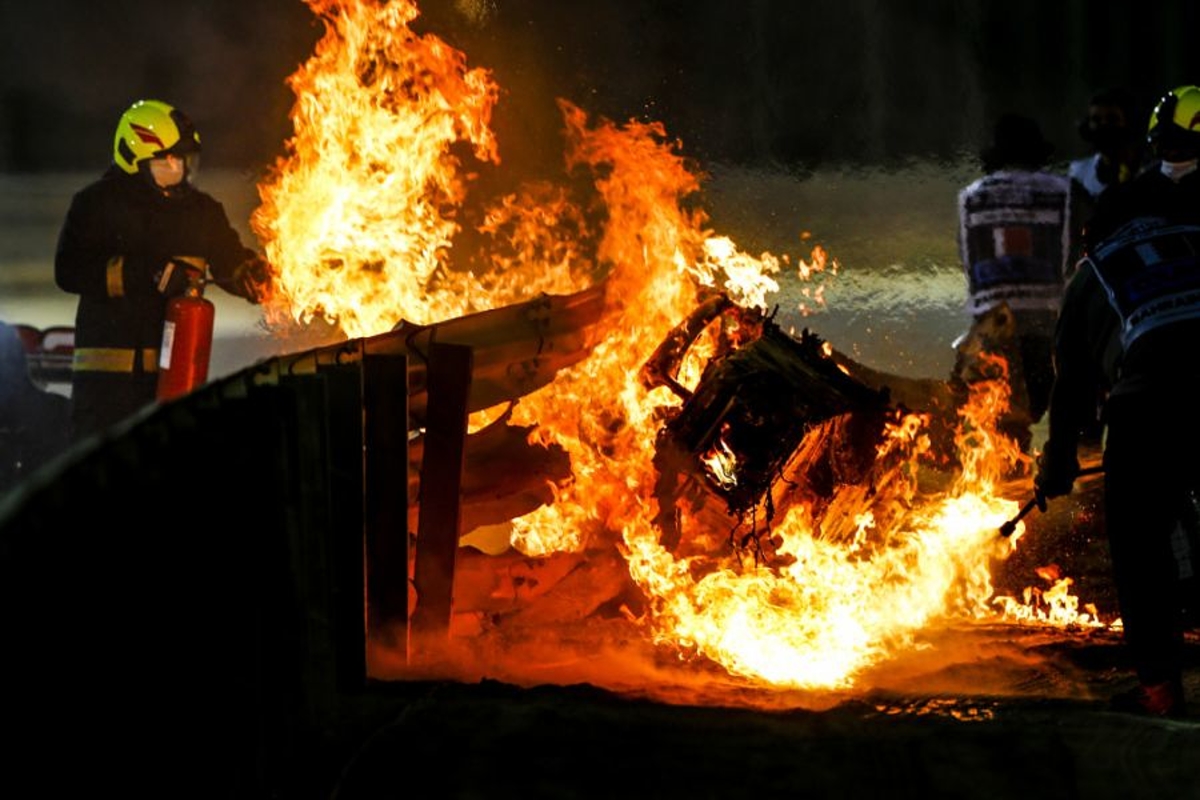The FIA has commenced what it has described as "a detailed analysis" of Romain Grosjean's fireball crash during Sunday's Bahrain Grand Prix.
Grosjean escaped with nothing more than burns to the backs of his hands after his Haas hit a barrier at 130mph, splitting the car in two and instantly bursting into flames.
The severity of the accident has resulted in a highly forensic probe being initiated by the FIA to understand the reasons behind what unfolded and to ensure additional safety improvements can be made.
FIA safety director Adam Baker said: “As with all serious accidents, we will analyse every aspect of this crash and collaborate with all parties involved.
"With so much data available in Formula 1, it allows us to accurately determine every element of what occurred and this work has already begun.
"We take this research very seriously and will follow a rigorous process to find out exactly what happened before proposing potential improvements.”
The FIA Safety Department typically investigates around 30 serious accidents in circuit racing worldwide each year and the Grosjean investigation will follow the same process.
The FIA has confirmed it will look at all areas, including competitor safety devices such as the helmet, HANS, safety harness, protective clothing, survival cell, headrest, in-car extinguisher system and the Halo frontal cockpit protection.
Further analysis will also include chassis integrity and the safety barrier performance given the impact energy of 53g and trajectory, as well as assessing the role of the track marshals and medical intervention team.
The FIA is to work with all parties involved, including the Formula 1 promoter, the Haas team and the Grand Prix Drivers' Association, of which Grosjean is a director, and which has already been contacted for input.
Remarkably, FIA researchers will gather data from the various video streams, including a high-speed camera which faces the driver and films at 400 frames-per-second to reveal in slow motion what happened to Grosjean during the accident.
Additional data will also be gathered from the in-car Accident Data Recorder, which will reveal the speed and forces on the car, and the in-ear accelerometers that are moulded to fit inside a driver’s ear canal to measure the movement of his head in a crash.
The FIA has confirmed the investigation is expected to take around six-to-eight weeks to complete before findings are made public.
This data is to be used by the FIA Serious Accident Study Group [SASG], chaired by FIA president Jean Todt, the composition of which includes doctors, engineers, researchers and officials, with accidents analysed from technical, operational and medical sides, and with measures then taken forward.
The SASG works in conjunction with the FIA Research Working Group (RWG), which peer reviews ongoing research into new safety devices and accident investigation conducted by the FIA.
The RWG is made up of an influential body of engineers within the motorsport industry that have experience across all levels of the sport, as well as medical experts who collaborate on matters of safety.
The investigative work related to serious and fatal accident cases is considered by the RWG before being examined by an extraordinary meeting of the FIA Safety Commission, chaired by Sir Patrick Head.
The findings are then presented to the World Motor Sport Council, the ultimate ruling body.
Related































 Gulf Air Grand Prix of Bahrain 2024
Gulf Air Grand Prix of Bahrain 2024  Saudi Arabian Grand Prix 2024
Saudi Arabian Grand Prix 2024  Grand Prix of Australia 2024
Grand Prix of Australia 2024  Grand Prix of Japan 2024
Grand Prix of Japan 2024  Grand Prix of China 2024
Grand Prix of China 2024  Gran Premio dell'Emilia Romagna 2024
Gran Premio dell'Emilia Romagna 2024  Grand Prix of Monaco 2024
Grand Prix of Monaco 2024  Grand Prix du Canada 2024
Grand Prix du Canada 2024  Gran Premio de España 2024
Gran Premio de España 2024  Grand Prix of Austria 2024
Grand Prix of Austria 2024  Grand Prix of Hungary 2024
Grand Prix of Hungary 2024  Grand Prix of Belgium 2024
Grand Prix of Belgium 2024  Grand Prix of Azerbaijan 2024
Grand Prix of Azerbaijan 2024  Grand Prix of Singapore 2024
Grand Prix of Singapore 2024  Gran Premio de la Ciudad de Mexico 2024
Gran Premio de la Ciudad de Mexico 2024  Grande Prêmio de São Paulo 2024
Grande Prêmio de São Paulo 2024  Qatar Grand Prix 2024
Qatar Grand Prix 2024  Grand Prix of Abu Dhabi 2024
Grand Prix of Abu Dhabi 2024 